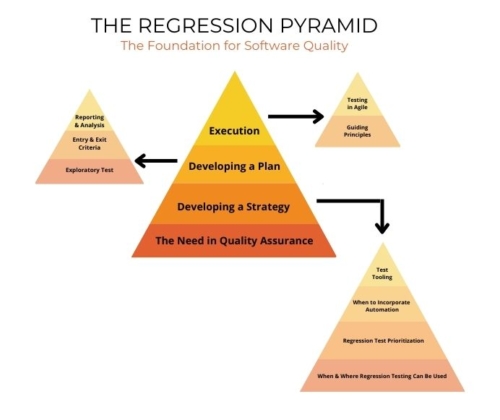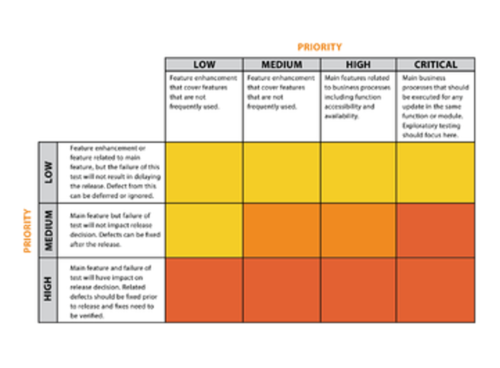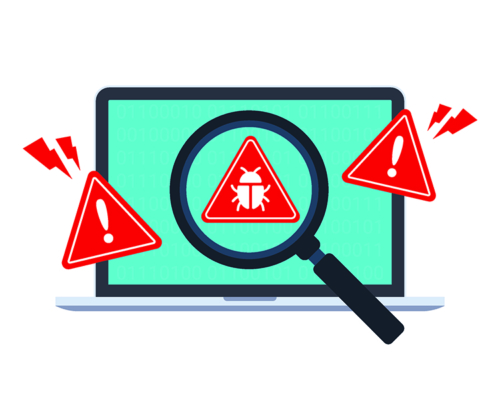Regression Testing Services
Your company can’t escape software changes. But you can avoid surprise defects regression testing.
Structured and thorough testing leads to high-quality software. Why? Because as DevOps teams have seen repeatedly, introducing even minor changes into existing code can have serious — and unpredictable — downstream consequences.
When new code is released, some testing must be carried out to ensure its functionality. Retesting old code that the product previously passed is equally important to confirm that any new changes do not introduce past defects or create new ones, which are called “regressions.” While regression testing appears to be a simple process, it can be pretty challenging due to limited time, personnel, and resources.
The secret to finding and addressing issues before they become problems lies in robust and effective functional regression testing techniques with the right strategy for testing existing functionality and new or changed functionality with a combination of manual regression testing and automated regression testing at the right time and place. The right time and place are integral to the strategy. Otherwise, you’d test everything all the time, everywhere, but obviously, who has the resources to do that?
At XBOSoft, it’s our goal to help shorten your regression software testing cycles through effective test processes and best practices.
XBOSoft provides comprehensive regression testing for projects of all complexity levels. Outsource your testing workload to our expert QA team and keep your developers focused on your business’s priorities.
Choose the Leading Provider of QA Solutions for Regression Testing
XBOSoft Combines Deep Technical Proficiency and Industry-Leading Tools to Make Your Software a Success.
Software changes are vital to ensuring your products are functioning correctly. But each time a developer modifies your software, there’s a good chance issues will show up downstream.
Every company understands the nightmare overlooked product bugs and unexpected defects can become. Your developers must pause mission-critical projects and spend time identifying and fixing issues that could have been addressed quickly and efficiently with a regression test.
This fix-it-later approach is far more expensive than getting testing from the start. It also risks your reputation, as bugs can wreak havoc on the user experience.
But with an experienced team to perform regression testing, you can shorten your test cycles and deploy software changes swiftly. You also don’t have to worry about downstream consequences harming your applications and slowing your business down.
XBOSoft is a leading-edge quality assurance and software testing company. Our team stays up-to-date on the latest best practices, enabling us to implement innovative and effective solutions.
We also live and breathe testing, which means there’s no testing scenario on the planet we can’t handle. Our team is equipped with the best tools and expertise to complete fast, reliable tests and help you launch successful software updates quickly.
Regression Testing: The Need for Quality Assurance
How Regression Tests Can Make (Or Break) Your Software
Regression testing is an essential element of software quality assurance. It provides the assurance and confidence that an application is ready for deployment. Most importantly, regression testing verifies that code changes do not re-introduce old defects, ensuring the quality of deployed software. Regression testing is critical to most QA processes, covering desktop, web, and mobile testing.
Many think regression testing happens only at the end and covers existing functionality. Still, regression testing is done throughout the software development lifecycle: from unit and integration testing to system and user acceptance testing. During unit and integration testing, regression testing can help catch defects early and thus significantly reduce the cost of resolving them.
Unfortunately, Regression Testing in Agile seems to never happen due to the objective of velocity and “working software.” Most often, “done” does not include regression testing but testing for that particular feature or function.
Unlock Your Developers’ Potential with Outsourced Regression Testing
Outsourcing can help you reduce costs, improve efficiency, and focus on your core business objectives while ensuring your software is thoroughly tested and defect-free.
- Expertise: Leverage the experience of skilled testing professionals specializing in regression testing. We will thoroughly test your software and identify any potential issues arising from new changes, including bugs that might slip under your radar.
- Cost savings: Save on expensive testing tools and training. With a reliable team of software testing experts, you don’t have to hire and train a dedicated testing team or invest in high-priced tools.
- Security: Get peace of mind when you work with XBOSoft. We use industry-leading security strategies, including data encryption and multi-factor authentication.
- Focus on core competencies: Focus on your core competencies and business goals while leaving the regression testing to the QA experts.
- Scalability: Scale your testing efforts up or down as needed without investing in additional resources or infrastructure.
Few companies have the internal resources necessary to complete regression testing successfully. Instead of over-burdening your developers and risking errors in the testing process, rely on the experts. We’ll put our tools, knowledge, and time to work for you.
Regression Testing Example
It’s All About Developing a Strategy.
Designing a regression testing strategy is often overlooked. However, it is still an essential part of the QA process
if the goal is to reduce total testing time without sacrificing software quality. Meeting this goal means evaluating your current methodology: How are you testing? Are you designing your regression test cases effectively? And how is your regression test selection efficient and context-driven? What are your results? Where can you improve?
As an application matures, it builds an inventory of regression test cases. Although test automation may be able to reduce the time and effort required for a regression cycle, it typically is impractical to automate the entire suite and execute every software change. But running only a portion of the entire test suite, such as unit-level regression tests, may not be sufficient to expose critical defects. An effective regression testing strategy, considering the available time and testing resources, should prioritize regression test cases of different types and methods to ensure that no critical regression tests are missed. This also entails an automation strategy to automate where it makes sense while applying your manual regression testing, which adds the most value.
There are many facets at play when working with regression tests. The Regression Testing Pyramids capture these elements and how they are connected.
XBOSoft’s Awards and Recognitions
Step 1
Knowing When and Where Regression Testing Can Be Used
Whether regression testing in Agile or not should be employed throughout the software development lifecycle, providing valuable insight and feedback into code quality and functionality. Many think that regression testing only occurs at the end of development, but the term regression means returning to a previous state. As such, regression testing intends to prevent defects or faults in the software from coming back after they were initially fixed or other parts were updated. This can happen throughout the development cycle with numerous types of testing, all to prevent previous problems from coming back. An overview of when and where regression testing can be used is given below:
Unit Testing
Check the functionality of individual modules by re-running previously passed tests for each modified module. Immediately after coding changes are complete for a single unit, a tester, – typically the developer responsible for the code – re-runs all previously passed unit tests. In test-first and test-driven development approaches, automated unit tests can be built into the code, making unit regression testing more efficient than other types of testing.
System Integration Testing
Combine individual modules and test their interaction by re-running previously passed unit tests and integration tests for all units that had changed, including targeted testing for modules that did not change. The testing scope would cover interface/APIs as well as back-end services. This confirms the functionality of the complete software product and that it works as designed. Additional testing could include performance regression testing, accessibility, compatibility, and security.
User Acceptance Testing
Verifies that the software product meets the needs of the end-users. Re-running previously passed system tests and GUI testing could be incorporated within the QA scope as part of the acceptance testing. Additional scripts can be run specifically from the end-users point of view either as part of manual regression testing (instead of automated regression testing) or targeted automated testing. For User Acceptance Testing, it’s critical to bring the end users or product owners in to ensure that you’re testing exactly how they would use it. It may be backward or different than what you thought.
Smoke Testing
Smoke testing is a spot check of high-priority regression tests executed after merging code changes. Smoke testing aims to ensure that core functionality is acceptable before moving on to additional testing. At XBOSoft, we recommend that smoke testing be an integral part of the QA process and employed every time software changes are pushed to the next cycle. Usually, smoke testing involves some manual regression tests but can be highly automated and part of continuous deployment initiatives.
Partial or Targeted Regression Tests
A partial regression testing approach identifies only specific tests to be run. Tests are often selected based on their priority and the functional area of the application. For example, an online retail business updates its payment processing application. In this case, the QA team may conduct regression tests for the payment process but exclude regression tests for other website areas, such as product search and side-by-side comparisons. In this approach, an established process for prioritizing regression test cases helps manage the QA effort. This is probably where a strategy combined with a deep understanding of how the software’s functionality is connected and intertwined helps the most and is most often overlooked.
Complete Regression
With complete regression, all regression test cases within the suite are executed. This is generally costly and not always practical, especially for minor releases. In general, a full regression test suite may be necessary for major releases with significant code changes, major configuration changes such as an interface to a new platform, or after an update to an operating system. Unfortunately, many think that complete regression is the only one that can sometimes take days and weeks to complete. However, with no regression strategy, testing everything becomes the default to feel confident in the software’s release.
Step 2
Prioritization
With short development cycles, we rarely have time for complete regression, so we have to choose wisely where to spend our time and how to balance risk management and software quality. It’s not an easy task to develop a test strategy in terms of where to put one’s effort; manual testing, automated testing, exploratory testing, platform compatibility, etc., while achieving the level of confidence that the release is ‘defect-free.’ Which test cases come first and when? Major release, minor release, patch release?
At XBOSoft, we’ve developed a regression test strategy matrix to provide some guidance when addressing these challenging questions. By using a matrix approach, you’ll be able to categorize test cases and test more effectively.
The following prioritization strategy employs three steps and assumes four priority levels: critical, high, medium, and low.
Step #2.1 – Assess Risks
Categorize “risk” according to the levels of low, medium, and high:
- Low – Feature enhancement or feature related to the main feature, but the test’s failure will not delay the release. Defects from this can be deferred or ignored.
- Medium – Main feature, but the test failure will not impact the release decision. Defects can be fixed after the release.
- High – Main feature and failure of the test will have a direct impact on the release decision. Related defects should be fixed before release, and fixes must be verified.
Step #2.2 – Assign Priority
Categorize “priority” according to the levels of low, medium, high, and critical:
- Low – Feature enhancements that cover features that are not frequently used.
- Medium – Related to main features, but no direct impact.
- High – Main features related to business processes, including function accessibility and availability.
- Critical – Main business process that should be executed for any update in the same function or module. Exploratory testing should focus here.
Step #2.3 – Apply Results of Steps A & B to Prioritization of Test Cases
- Begin by selecting test cases that verify critical functionality and core features and link to those with the greatest risk of failure. This can be because the feature is critical to the system (high level of risk) or because the functionality is complex and prone to failure.
- Security tests dealing with customer data that should be kept secure and private should be prioritized as high or critical.
- Test cases with high code coverage or a high level of associated defects in the past can be assigned a high priority.
- Assign high priority to functional and regression testing cases that cover the most common use cases.
- In general, negative test cases can default to medium priority. Negative test cases verify the handling of “negative” situations, such as entering a wrong username or password in a login attempt.
- Generally, all validation tests can default to medium priority, including edge-type cases, corner cases, and exceptional value cases.
- Depending on how well you know your application and understand the nature of the code changes, you may treat non-functional and regression testing as a low priority for regression testing.
- After all test cases have been prioritized, reassess those that cover areas of particular risks, such as security, or test cases that verify compliance with regulations.
- As a “best practice,” periodically archive regression tests that no longer serve a purpose. These could be test cases that cover functionality that no longer exists in the application or medium- and low-priority tests that have not revealed any defects in several rounds of regression testing.
You may think that this is too much trouble… But modern test management tools have many features that enable you to pick out, label, and extract test cases for targeted regression and prioritization.
Per the graphic below, the colors between the cells would be contiguous shading and would not be that distinct. Red would be for tests executed with every release, no matter what, whereas yellow would only be for full regression.
Clients Who Trust XBOSoft
Step 3
When to Incorporate Automation
In the past many thought that automated software testing was too expensive or complicated, especially given the cost of tools and the expertise needed to master them. However, in today’s shortened release cycles, test automation as an integral part of DevOps is the new normal.
In most cases, test automation is used as an effective means to reduce overall testing costs while increasing test coverage and effectiveness and shortening testing cycles. Automation has various intangible benefits, such as reaching the market faster and improving tester morale (and productivity) by eliminating tedious tasks. But there is an upfront investment in tooling and gaining expertise to make it worthwhile. Many shops may buy an automation tool, only to let it sit there for years…
Sound familiar?
Some may be sitting on the fence even today, deciding whether or not to automate software testing even after hearing of all the benefits of test automation. On the other hand, some blindly dive into a buy a test automation tool without carefully considering where and when to use test automation as an integral part of regression testing.
A successful regression testing strategy must contain a baseline understanding of test automation and where it fits best with the organization and its software. Key considerations are:
- Identify Test Automation Objectives
- Review and assess regression testing tools for automation to determine what best fits the overall strategy and team skill sets.
- Develop a Test Automation Strategy, Automation Test Case Design and Parameterization Guidelines, Test Automation Architecture, and Automation Framework Design Guidelines.
- Validate the steps above by creating and executing proof-of-concept automation scripts using the selected automation tool.
XBOSoft recommends the above include written guidelines on how to set up the test environment, deploy and execute scripts, maintain and extend the automation test scripts, and incorporate best practices in the test results analysis. Analyzing test results is probably the most challenging task in any testing, especially regression. Does anyone bother with dashboards anymore?
Step 4
Open Source
One of the more difficult challenges that QA personnel may face is deciding what testing tool(s) to use and for what purpose. There are many variables that management must consider when selecting tools for QA software; budget, tester or team experience with test tools, and even business goals and strategies; added to the decision matrix are the numerous software test tool vendors, each with their own broad set of features and functions, some of which you need now or in the future, but many that you don’t need today and perhaps may never need. That’s why, as discussed earlier, it’s essential to understand your objectives before shopping clearly. Don’t go to the grocery store with an empty stomach!
As a company specializing in software testing services, we have learned a thing or two about automated regression testing tools. We generally chose open-source platforms over proprietary ones, not because of cost but because of their flexibility and capabilities. Depending on how they are implemented, they can be used for simple scenarios or scaled up to meet the needs of testing complex software with frameworks that ensure maintainability and extension requirements.
Additionally, with many developers dedicated to refining the software through 3rd party plug-ins, there are usually canned solutions for problems you are encountering or additional functionality you want to add to the base tool. In this environment, if there are issues with security and quality, they surface quickly and are rapidly addressed. Finally, open-source solutions have a supporting development community that serves as a valuable resource and are easily integrated with other tools via open interfaces instead of closed proprietary systems.
Whether you use open-source or proprietary tools, we recommend building a regression framework from the ground up that addresses your specific needs and can be continuously adapted to ensure future growth and automation needs. The last thing you want is to re-boot your automation effort from scratch after discovering that your tool or framework won’t suit your ongoing needs.
Step 5
Developing a Plan
To create an overall system-level regression test plan, begin by defining the entry and exit criteria and time boundary for each type of regression test. The time boundary is essential because one type of testing may depend on another, and testing time can naturally expand with no time boundary.
- Entry criteria may include that all software changes have passed unit testing, a green build has passed smoke and sanity testing, and the regression test suite is prepared.
- Exit criteria may include that all priority test cases have been executed, all defects have been reported, all defects have either been resolved or deferred for future resolution, and the product owner or customer has signed off.
Identify the test cases or types that will be part of the regression test suite. Remember that you may have different regression test suites for different purposes. Include test cases for recently-changed code and defects recently found and fixed. Exclude test cases for known defects that have not yet been resolved. Finally, automate reusable test cases for the coverage of core features.
In the plan, allow time for exploratory testing, as exploratory testing tends to find more issues than existing test cases and test automation. Also, allow time to conduct post-testing reporting and analysis. Otherwise, you’ll never be able to improve. Maintenance is also critical as some tests become invalid while others may shift in priority or become broken-blocked and need updating. It would be best if you had a version control system for the regression tests, whether automated or manual test cases.
Regression Testing – Reporting and Analysis
What information do the stakeholders need to make “quality” assessments, and what information do you have readily available? The reporting should include whatever metrics are deemed necessary, no more and no less. The last thing you want to do is produce reports no one reads. Additionally, as your regression testing process changes and adapts over time, you may change your focus and use different metrics to support your focus. Some examples of questions that proper reporting can help answer:
- Where to test more or less
- What tests should be executed or not
- What tests are effective
- Should more tests be added
- Where is QA spending the most time
- What features or functions need refactoring
- Overall product quality assessment
A key value in having a process for evaluating “product quality” is that it can provide warning signs when a change in regression testing techniques may be warranted.
Step 6
Execution in an Agile Environment
Testing features as you go in Agile without strategically aligned regression testing is a formula for disaster. But who has the time? And delaying testing into a subsequent sprint incurs technical debt, while performing regression testing only limited testing increases the risk that defects will make it into production.
The need for regression testing has only increased as software development life cycles have compressed since even minor modifications can impact the software’s behavior and interfacing 3rd party components. While some companies opt for unit testing and limited smoke testing to ensure usability and assume that code will remain more or less functional, this ignores the cascade effect that often occurs when alterations are made not just to the software itself but to the way the software behaves in conjunction with the surrounding context of platforms and peripheral plug-ins and interfaces.
At XBO, Agile regression testing starts with designing compelling user stories with acceptance criteria and test cases that complement and verify the user story. These test cases must be ready to execute as soon as coding completes on a user story to avoid becoming a bottleneck. With the “right” Agile test cases, we can evaluate where to expend the testing resources through “smart” regression test selection for targeted regression via test automation.
Below are some recommendations for optimizing your quality assurance resources with the limited time available in an Agile life cycle:
- Create tasks in the sprint specifically for creating and grooming user stories.
- Create a task in the sprint to create automation scripts for regression testing. These can be identified from the previous development iteration. Complete this task early in the sprint.
- Ensure developers follows test-first practices by utilizing automated unit tests for new code.
- Build time into the sprint for manual and exploratory testing of the user stories. This should be tested as development finishes each story.
- Apply risk-based prioritization to manage the size of the regression test suite.
- Use a dedicated server to run unit and integration tests for each application build.
- Understand and track time for each type of task; user story creation, user story modifications, development, manual testing, automated testing suite creation, and test automation maintenance.
- It is not necessary to run the entire regression suite for each build, but do run it at meaningful intervals.
Finally, make a clear definition of ‘done’ understood by all team members such that only user stories that have passed all regression tests should be designated as “done.”
Regression Testing Guiding Principles
The Key to Best Practices.
It’s challenging to have “best practices” as what is best for one organization may not be best for another or prioritized for another, based on context. However, developing guiding principles to lean on when making decisions and establishing your organization’s priorities and direction is possible. Our regression testing approach is founded on a set of essential guiding principles, including:
Automation Feasibility
Can specific test processes be automated? Our test automation assessment (see below) helps you determine where best to apply automated regression testing and reduce the amount of manual testing while also focusing manual testing in the right places.
Continual Alerts
Testing results are analyzed and tracked; Your team is quickly alerted to quality degradations and defect counts between existing and new software built to prevent code degradation over time.
Organization
Our regression testing process systematically organizes and categorizes results to allow partial regression runs, and cases are combined into typical (and adverse) user scenarios to empower acceptance testing.
New Methodologies
To enhance usability and speed, XBOSoft has also developed visual regression testing techniques that make identifying issues easier and creating effective testing solutions. We’re constantly evaluating new tools and methods, such as employing some of the newest AI-powered tools to understand where testing should be focused and how to minimize test automation maintenance costs.
XBOSoft – 10+ Years of Performance Testing Experience
Experience Matters.
Our regression testing services are designed around proven techniques that do more than identify defects. The combination of our needs-first approach, the suitable types of regression testing and regression test cases, open-source testing tools, and critical best practices make it possible to increase delivery speed while improving the quality of your testing results. Reduce each regression testing cycle while improving your software deployments’ usability and functionality. Whether you are in the automated or manual regression testing market, XBOSoft has a team ready to meet your needs.
Recent Regression Testing Blog Posts
What is Regression Testing?
By Philip Lew | June 21st, 2022
In November 2021, Tesla recalled 12,000 vehicles. The reason? All these vehicles had a bug that made them suddenly stop because of a false Forward Collision Warning (FCW)…
Visual Regression Testing Market Challenges and Opportunities
By Philip Lew | April 12th, 2022
In a previous post, XBOSoft was mentioned in another report on the Visual Regression Testing market. In that post, we discussed what visual regression testing is and why the market is growing.
XBOSoft Featured in Global Visual Regression Testing Market Report
By Philip Lew | October 26, 2021
Regression testing tests the features and functions of the software to ensure that changes you made did not cause any unexpected errors (defects) in other parts of the software.









